“Please don’t be too polite,” said Joanne Dwyer, after reading the first of several poems from her first book, Belle Laide. “I want poetry readings to have a little more life in them. Be yourself… heckle me a little!” Before her reading began on Tuesday, Sept. 24 at SFUAD’s O’Shaughnessy Performance Space, Dwyer had admitted she was nervous, telling a friend that normally she spends “days and days and days not seeing anybody.” Once in front of the podium, however, she commanded the audience with a combination of humor, naked earnestness, and a reading voice that gave no sign of shaking. Dwyer straddles these sorts of dualities— internal shyness and outward composure—in her writing as well as her life. On one hand, she loves the fragmentation and collage of poetry, the way that “words and how we string them together are our tools as writers.” The rules in poetry are different, Dwyer says, so she feels free to let “imagination reign free to create image, sound and tonality without the normal everyday mundane rules of language.” At the same time, however, Dwyer admits that maybe the fragmentation and shorter form of poetry just matches her attention span better as a writer than fiction would. She loves reading fiction—making an effort to read Marquez’s One Hundred Years of Solitude annually—but says that, “the idea of writing a plot is just terrifying.” Her poetry, she explains, does not look for a truth in the way that a novel might. “Sometimes,” she says, “even I couldn’t tell you what the hell it’s about—that’s the magic of poetry, but sometimes I wonder if it’s to my detriment as a writer, if I’m just hiding behind the language.” Still, Dwyer is praised for her stream-of-consciousness and vocabulary-rich writing. She writes, says Creative Writing Co-chair Dana Levin, who taught Dwyer as a student at the College of Santa Fe, “in a way that tracks how the mind thinks. It is associative rather than linear.” Dwyer keeps this interesting by avidly reading up on everything historical, mystical and etymological that catches her attention and then working them into her poems. The mind, especially when its imagination is unfettered, is full of surprises. “The poetry that stays with me, that gives me an ecstatic juice,” says Dwyer, “is poetry that surprises me.” Dwyer both feeds and welcomes these surprises in her own writing by reading extensively, watching the world around her, and letting her own imagination string them together on the page. Dwyer, a 2005 graduate of CSF in creative writing and literature, does not lament how little time she has to write like many writers do. A mother of two, Dwyer’s says that being a mother made her a better writer, and visa versa. She recalls hearing a quote from Toni Morrison in which she says that she has written novels and won prizes, but really she neglected her son. “This really surprised me,” says Dwyer, “because I think that when there’s tension in your life, and you’re really living in the real world at the same time that you’re creating, you fight harder for that creative time.” When Dwyer began to feel that she’d spent enough time indulging in the reclusive act of reading and writing—for which she felt very lucky—she became involved in the Brooklyn-based Alzheimer’s Poetry project. “It just seemed like time to give something back,” she says. She would read poetry out loud to dementia patients in nursing homes, many of whom were losing their mental capacity for language. Dwyer found this process rewarding on many levels, and still makes regular visits to nursing homes around New Mexico. “Some of them had to memorize poems when they were young,” she exclaims, “and they remember them when I start to read. The whole thing becomes a sort of call and answer.” The return to dignity—let alone language—that she sees in the elderly, who...
Art for Everyone
posted by Charlotte Martinez
They look at me as if they don’t understand. “What does Progressive Art mean to you?” I ask again. The two women smirk at one another. Maybe I’m missing something. They are the organizers of the Santa Fe Art Resource website, after all, the information booth for everything art in Santa Fe. One is Julie Ruth, an out-of-practice artist, and the other is Christy George, a sculptor who previously taught at SFUAD. They both sit at their booth, Sunday Sept. 15, during Santa Fe’s 3rd Annual AHA Festival of Progressive Arts, a community-sponsored event dedicated to its local artists. “If someone called me a progressive artist,” George begins, “I might want to slap them, but I’m not sure. I mean I am a progressive artist, but how do I feel about that?” They look at each other again. Ruth is fixing her shoe with duct tape. “Progressive in the sense that it’s designed to make progress,” George says. “It’s part of the community…that’s one of the problems with contemporary art these days, in that it exists in these sterile white wall environments and it’s intimidating.” “They’re taking art to everyone,” Ruth says. “Kids can interact with it…there’s something for everyone here.” She’s right. As families take in the booths of AHA Fest, the kids color on “sterile white walls,” run through installations as if they were monkey bars, and reach out to touch red-haired Rag and Tag, the clowns of Flying Wall Studios Puppet theater. Remember this? Playing? Garson Dance Company from SFUAD definitely has fun contributing to the progressive afternoon. Wearing white muscle shirts, jean shorts and black canvas shoes, the seven dance majors ease and speed their way through the Farmer’s Market side street and onto the train track sidewalk with some exciting train mimicry and smooth moves. “I’m tired,” freshman Stephanie Martinez says, after what is to be the first of many performances. “Half way through I was like ‘I need water!’ You wouldn’t think it’s tiring, but…” Martinez marks an extraneous kick and sticks her tongue out in exhaustion. Message received. Martinez explains that though she has done some experimental Summer intensives, she’s never done site-specific dance. “It was very different,” she says. Speaking of site-specific dance, I am drawn next to the gallery space at Site Santa Fe, across the street from the Farmer’s Market, where a mesmerizing collaboration with Arcos Dance company takes place. Camouflaged by grey walls and the dark shadows of Enrique Martinez Celaya’s art, these dancers ease, like drops of honey, from installation to installation until they all merge and break out in full body dancing. Their faces, never breaking character, stare off into the paintings hung on the wall or into the faces of the audience members, who can’t help but stare back. When I return to the main AHA Fest sidewalk, there is much more play occurring. I say play, because what else would you call young women screeching and screaming to unsteady and unpredictable noise other than play for adults? Helen Gruhlkey and her partner Vodi Grontis call it “Distortion by Design,” a mixture of environmental sounds and noise. In addition to soundboards and vintage music sheets, Gruhlkey’s installation exhibits photos of garbage and street litter. I ask about those. Gruhlkey explains that many of their sounds come from the large amounts of trash they pick up from their community and, if I’m not mistaken by the connection here, they hope to call attention to the waste problem by performing their “sounds” for the public. And it is quite the whaling sound. And “Distortion By Design” is not the only sound cascading through the side street of the farmer’s market. Anyone within three blocks of the Railyard can hear the hard rock rage from the band stand, which throughout the afternoon includes performances by Alamo Sun, Lady Gloves, Accordion Crimes, Lily Taylor, Jupiter Spiral, Evarusnik, Adam...
Viva la Fiesta
posted by Shayla Blatchford
By Shayla Blatchford Even though the props and events of Fiesta have packed up their bags and gone, the spirit of Fiesta never departs. Over the past few years, I’ve been able to observe the various ways in which locals celebrate and interpret the cultural holiday. For some, it’s about family and culture, a deeply rooted appreciation for their town and history. Others may find Fiesta as a time to simply celebrate life and share it with friends over seasoned corn in a cup along with some agua fresca. Either way, during this week of festivities, it seems as though the whole town comes together as family. With the highlight of the week being Zozobra, friends and families trickle down and around Fort Marcy Park to watch a 40-foot effigy of Old Man Gloom go up in flames. The giant paper mâché puppet represents the troubles and gloom of the past year and once it goes up in flames, so does your gloom! In some aspects, it is very much a communal and religious ceremony. Everyone admits to experiencing some gloom by simply attending the burn. I even heard a young woman comparing Zozobra to Santa Claus as a child. Until this day, she still believes that “Zozo” will take away her gloom each year and she can move on and start over. Some people choose to officially attend Zozobra by buying a ticket that allows you an up-close experience. From an aerial view, you can see that the entire Fort Marcy baseball field is packed with families, 20-somethings, and food vendors of all sorts. For those who prefer not to pay the $10 entrance fee, Fiesta parties can be found at every house lining the road that leads you to Zozobra. This year, I...
Historical Hysterical Parade...
posted by Amanda Tyler
Early on a Sunday afternoon, people of all ages gather around the streets of the Santa Fe plaza. Near 1 pm, floats representing local football teams, marching bands and even credit unions go past the crowds of umbrellas and lawn chairs that line the sidewalks. This parade, lovingly nicknamed the Historical/Hysterical parade, welcomes any and all floats or groups that wish to participate, and is a staple experience in the events surrounding...
THE MEANING OF ZOZOBRA...
posted by Maria Costasnovo
Thousands of people come from other cities and states to be a part of Santa Fe’s Zozobra celebration: the burning of a giant marionette called “Old man Gloom” or “Zozobra,” which dispels the hardships and travails of the past year. Zozobra means, literally, “anxiety” in Spanish, but what does Zozobra really means for people who come to the oldest capital city in the United States for this celebration? If there was a synonym for Zozobra at the Sept. 5 burning, it was “family.” The whole Fort Marcy Park was full of families sharing just their time. Ben Gomez, a Vietnam veteran, has been coming to this event since he was a kid. He used to bring his son; now also his granddaughters come with them. “It’s an important day because the whole family meets every year. When my son was a kid, he danced up there. We just come here, sit in the yard and spend the whole day together. For us this is an important tradition, we all come together, buy funny hats and we become this in a family day. We just enjoy being together.” Friendship also had its place at Zozobra. The whole park was full of teenagers, both enjoying themselves, and volunteering. One group had come from Northport School, in New York, as part of the International Baccalaureate Program. In this program, they go to a city every year to help in any event. Last year, they went to New Orleans, and this year they came to Santa Fe, where they seemed impressed with the city and the event itself. “This is really different from New York, and we love it,” Anna said. “Yesterday we were in Pueblo, helping in one of the kitchens for poor people, and today we...

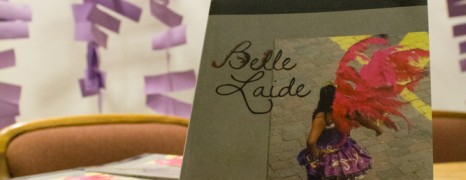
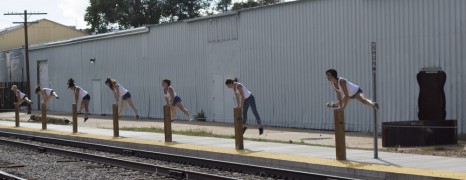
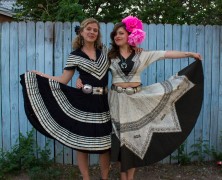
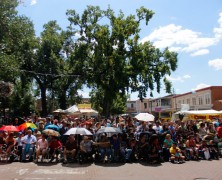
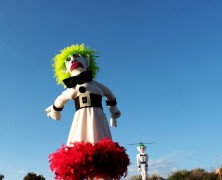
 Jackalope Magazine is the student magazine of Santa Fe University of Art and Design. Building on the interdisciplinary nature of our education, we aim to showcase the talent of our university and character of our city.
Jackalope Magazine is the student magazine of Santa Fe University of Art and Design. Building on the interdisciplinary nature of our education, we aim to showcase the talent of our university and character of our city.
Recent Comments